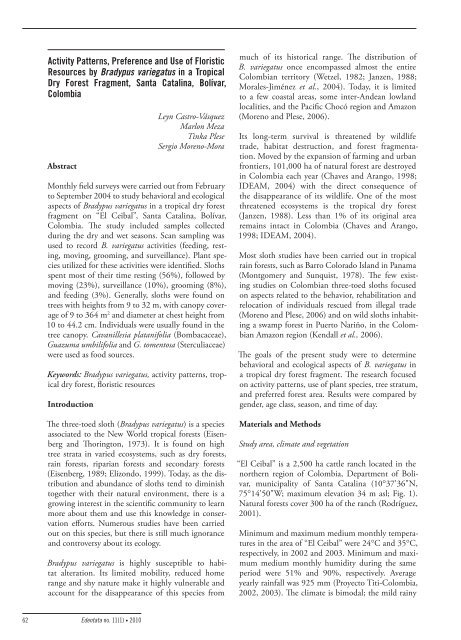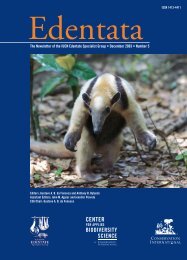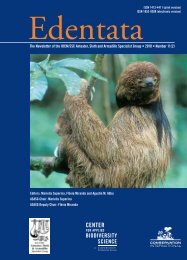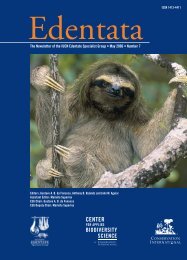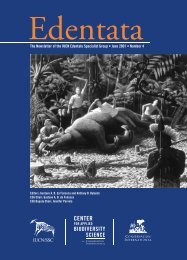Edentata 11(1) - Anteater, Sloth & Armadillo Specialist Group
Edentata 11(1) - Anteater, Sloth & Armadillo Specialist Group
Edentata 11(1) - Anteater, Sloth & Armadillo Specialist Group
Create successful ePaper yourself
Turn your PDF publications into a flip-book with our unique Google optimized e-Paper software.
Activity Patterns, Preference and Use of Floristic<br />
Resources by Bradypus variegatus in a Tropical<br />
Dry Forest Fragment, Santa Catalina, Bolívar,<br />
Colombia<br />
Abstract<br />
Leyn Castro-Vásquez<br />
Marlon Meza<br />
Tinka Plese<br />
Sergio Moreno-Mora<br />
Monthly field surveys were carried out from February<br />
to September 2004 to study behavioral and ecological<br />
aspects of Bradypus variegatus in a tropical dry forest<br />
fragment on “El Ceibal”, Santa Catalina, Bolívar,<br />
Colombia. The study included samples collected<br />
during the dry and wet seasons. Scan sampling was<br />
used to record B. variegatus activities (feeding, resting,<br />
moving, grooming, and surveillance). Plant species<br />
utilized for these activities were identified. <strong>Sloth</strong>s<br />
spent most of their time resting (56%), followed by<br />
moving (23%), surveillance (10%), grooming (8%),<br />
and feeding (3%). Generally, sloths were found on<br />
trees with heights from 9 to 32 m, with canopy coverage<br />
of 9 to 364 m 2 and diameter at chest height from<br />
10 to 44.2 cm. Individuals were usually found in the<br />
tree canopy. Cavanillesia platanifolia (Bombacaceae),<br />
Guazuma umbilifolia and G. tomentosa (Sterculiaceae)<br />
were used as food sources.<br />
Keywords: Bradypus variegatus, activity patterns, tropical<br />
dry forest, floristic resources<br />
Introduction<br />
The three-toed sloth (Bradypus variegatus) is a species<br />
associated to the New World tropical forests (Eisenberg<br />
and Thorington, 1973). It is found on high<br />
tree strata in varied ecosystems, such as dry forests,<br />
rain forests, riparian forests and secondary forests<br />
(Eisenberg, 1989; Elizondo, 1999). Today, as the distribution<br />
and abundance of sloths tend to diminish<br />
together with their natural environment, there is a<br />
growing interest in the scientific community to learn<br />
more about them and use this knowledge in conservation<br />
efforts. Numerous studies have been carried<br />
out on this species, but there is still much ignorance<br />
and controversy about its ecology.<br />
Bradypus variegatus is highly susceptible to habitat<br />
alteration. Its limited mobility, reduced home<br />
range and shy nature make it highly vulnerable and<br />
account for the disappearance of this species from<br />
much of its historical range. The distribution of<br />
B. variegatus once encompassed almost the entire<br />
Colombian territory (Wetzel, 1982; Janzen, 1988;<br />
Morales-Jiménez et al., 2004). Today, it is limited<br />
to a few coastal areas, some inter-Andean lowland<br />
localities, and the Pacific Chocó region and Amazon<br />
(Moreno and Plese, 2006).<br />
Its long-term survival is threatened by wildlife<br />
trade, habitat destruction, and forest fragmentation.<br />
Moved by the expansion of farming and urban<br />
frontiers, 101,000 ha of natural forest are destroyed<br />
in Colombia each year (Chaves and Arango, 1998;<br />
IDEAM, 2004) with the direct consequence of<br />
the disappearance of its wildlife. One of the most<br />
threatened ecosystems is the tropical dry forest<br />
(Janzen, 1988). Less than 1% of its original area<br />
remains intact in Colombia (Chaves and Arango,<br />
1998; IDEAM, 2004).<br />
Most sloth studies have been carried out in tropical<br />
rain forests, such as Barro Colorado Island in Panama<br />
(Montgomery and Sunquist, 1978). The few existing<br />
studies on Colombian three-toed sloths focused<br />
on aspects related to the behavior, rehabilitation and<br />
relocation of individuals rescued from illegal trade<br />
(Moreno and Plese, 2006) and on wild sloths inhabiting<br />
a swamp forest in Puerto Nariño, in the Colombian<br />
Amazon region (Kendall et al., 2006).<br />
The goals of the present study were to determine<br />
behavioral and ecological aspects of B. variegatus in<br />
a tropical dry forest fragment. The research focused<br />
on activity patterns, use of plant species, tree stratum,<br />
and preferred forest area. Results were compared by<br />
gender, age class, season, and time of day.<br />
Materials and Methods<br />
Study area, climate and vegetation<br />
“El Ceibal” is a 2,500 ha cattle ranch located in the<br />
northern region of Colombia, Department of Bolivar,<br />
municipality of Santa Catalina (10°37'36"N,<br />
75°14'50"W; maximum elevation 34 m asl; Fig. 1).<br />
Natural forests cover 300 ha of the ranch (Rodríguez,<br />
2001).<br />
Minimum and maximum medium monthly temperatures<br />
in the area of “El Ceibal” were 24°C and 35°C,<br />
respectively, in 2002 and 2003. Minimum and maximum<br />
medium monthly humidity during the same<br />
period were 51% and 90%, respectively. Average<br />
yearly rainfall was 925 mm (Proyecto Titi-Colombia,<br />
2002, 2003). The climate is bimodal; the mild rainy<br />
62<br />
<strong>Edentata</strong> no. <strong>11</strong>(1) • 2010


